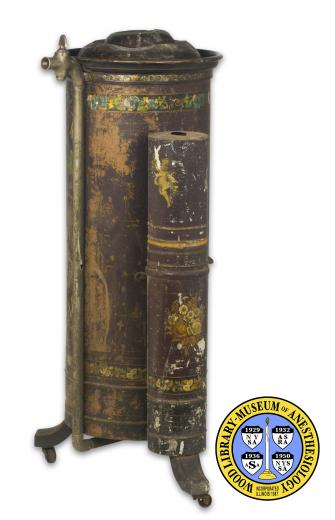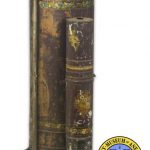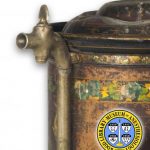Long Gasometer
The Long Gasometer was designed by Amos M. Long, a dentist in Monroe, Michigan, and patented on March 4, 1884. It is but one example of equipment used for the administration and storage of nitrous oxide (N2O) during the late 1800s to the early 1900s. Gasometers could be found in dental offices where nitrous oxide was heavily used. Some practitioners favored gasometers for their decorative function as well as for the N2O storage capacity they provided. Compressed N2O was delivered to the dentist in an iron gas cylinder (or tank), which was held in the smaller of the gasometer’s two cylinders. For use, the N2O would be released into the gasometer's large tank, which could hold multiple gallons of the gas. The complete gasometer would also have had attachments and tubing for the administration of chloroform or ether with the nitrous oxide.
Catalog Record: Long Gasometer
Access Key: aixy
Accession No.: 1999-01-25-1
Title: Long’s improved apparatus for producing anaesthesia / [designed by Amos M. Long].
Author: Long, Amos Marion.
Title variation: Alt Title
Title: A.M. Long gasometer.
Title variation: Alt Title
Title: Long’s gasometer.
Publisher: [S.l. : s.n., 1884-1910.]
Physical Description: 1 anesthesia machine : tin, copper, nickel-plating, cast iron, other metals, paint ; 95 x 52 x 41 cm.
Subject: Anesthesia Machines.
Subject: Nitrous Oxide.
Note Type: General
Notes: Title from markings on the apparatus. Alternate titles from the WLM name for
the object and from a ca. 1910 medical instrument catalog.
Note Type: Citation
Notes: Duncum BM. The Development of Inhalation Anaesthesia. London: Royal Society
of Medicine Press; 1994:290-291.
Note Type: Citation
Notes: Guilford SH. Nitrous Oxide: Its Properties, Method of Administration and
Effects. Philadelphia: Spangler & Davis; 1887:42-44.
Note Type: Citation
Notes: Johnston Dental Co. Catalogue of dental supplies. Richmond, Va.: Johnston
Dental Co.; ca. 1910:507.
Note Type: Citation
Notes: Turnbull L. Artificial Anaesthesia: A Manual of Anaesthetic Agents and Their
Employment in the Treatment of Disease. Philadelphia: P. Blakiston, Son & Co.
; 1896:367.
Note Type: Physical Description
Notes: An anesthesia machine composed of a large cylindrical tank (approx. 85 cm in
height and 36 cm in diameter) and a smaller cylindrical tank (approx. 66 cm
in height and 13 cm dia.), on a shared base with three wheels; A bracket
holds the small cylinder to the large one; The base appears to be made of
cast iron; The exterior of the apparatus is ornately decorated; The exterior
also has dents, rust, pealing decals and flaking paint; There are
manufacturer markings on the base of the larger tank: “LONG’S [new line]
IMPROVED APPARATUS FOR [new line] PRODUCING ANAESTHESIA [new line] PAT’D
MARCH 4, 1884”; A port to connect tubing to deliver nitrous oxide to the
patient is on the upper rim of the larger tank; The top of the smaller tank
is no longer removable due to rusting.
Note Type: Reproduction
Notes: Photographed by Mr. William Lyle, September 23, 2010.
Note Type: Historical
Notes: Amos M. Long was a dentist in Monroe, Michigan. His gasometer is but one
example of equipment used for the administration and storage of nitrous oxide
(N2O) during the late 1800s to the early 1900s. Gasometers were often used in
dental offices where nitrous oxide was heavily used. Some practitioners
favored the gasometer’s decorative function as well as the nitrous oxide
(N2O) storage capacity is provided (Duncum, 1994 ; Guilford, 1887). The N2O
was delivered to the dentist in an iron gas cylinder (or tank), which went
into, and was held in, the smaller of the two tanks of the gasometer. The N2O
would be released from the iron cylinder into the gasometer’s large tank,
which could hold multiple gallons of the gas. Although not held by the WLM,
attachments and tubing for the administration of chloroform or ether with N2O
were available for use with the gasometer (Johnston Dental Co., 1910 ;
Turnbull, 1896).




